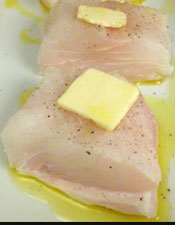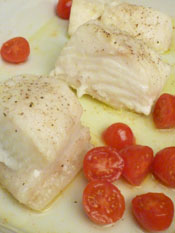Baking Fish
- Servings: 4.
One of the most frequently asked questions sent to me at The City Cook is how to get the smell of cooked fish out of our apartments. It's an olfactory problem not only for those of us who live in small spaces but also home cooks with houses. Because no matter the size of a kitchen, the smell of cooked fish can stick around for days.
There's no simple solution because what we continue to notice for days after that dinner is a trace of fish oil that stays on the surface of a wall or cabinet or ceiling near the stove. This happens even if you didn't fry the fish because it's not the oil you may have added for cooking, but instead oil from the fish itself.
We've separately published a short article that notes the only methods that I've ever found that worked to eradicate the smell faster than the three or so days it can take for the odor to naturally fade (or else we just get used to it!).
If you bake your fish instead of cooking it on the stovetop it goes a long way to prevent the problem. But there's a reason many of us prefer sautéed fish -- baked fish can be dry and tasteless. What I've learned about baking fish is two things: One, some fish bake better than others, especially the fleshier fish like halibut, cod and salmon. And two, which baking method you choose can make a big difference in keeping the fish moist and tender.
One of the most flavorful baking methods is to encase a whole fish in a crust of sea salt. While this method is in fact very easy -- and not at all salty -- nonetheless it is a bit of a production, if only because you've got to crack the baked salt crust and extricate the fish when it's done. You may prefer to save this method for cooking for company because it has a degree of virtuosity for which you might like an audience.
Another solution is to bake fish with something with lots of moisture, such as tomatoes. We've added links to recipes for both the salt crust-baked whole fish as well as a favorite recipe for baking snapper or tilapia with cherry tomatoes and artichokes.
Slow-Baked Halibut
A third method uses a lower oven temperature -- 300° F -- for about twice the usual time. In this case, 45 minutes to slow-roast pieces of halibut filet. If you buy your fish on the way home from work, turn on the oven as you walk in the door to pre-heat while you take off your coat, you can have a dinner of Slow-Baked Halibut on the table in an hour.
Use a filet cut of halibut, not the steaks. And if you don't like halibut, you can substitute cod, black cod or salmon.
Ingredients
- 1 pound halibut filet, with the skin left on
- 2 to 3 tablespoons extra virgin olive oil
- 2 tablespoons unsalted butter
- Salt
- Freshly ground black pepper
- Lemon wedges
Directions
- Pre-heat the oven to 300° F.
- Rinse the fish and pat it dry with a paper towel. Cut into large, serving size pieces but leave the skin on. You can remove the skin after it's cooked but leaving it on helps hold the fish together while it cooks.
- To a large baking dish or medium-sized roasting pan, drizzle a tablespoon or so of olive oil to just slick the bottom of the pan.
- Place the fish into the baking dish, drizzle with the other tablespoon of olive oil, and place about a teaspoon of unsalted butter on each piece of fish. Add a pinch of salt and a few grinds of pepper.
- Bake for 40 to 45 minutes, until the fish is opaque and just cooked through.
- Serve immediately with a wedge of fresh lemon.
This cooked fish is pale in both color and flavor and thus partners well with a vibrant green vegetable like broccolini or anything with citrus, such as lemon risotto. I also like it with a spoonful of salsa or a handful of sliced cherry tomatoes.
My favorite cookbook for all things fish is Fish Without A Doubt by Rick Moonen and Roy Finamore. For any of you who want to cook fish more often and do a better and more flavorful job of it, this splendid book will inspire and guide you. Plus the back of the book is filled with excellent go-with dishes like slaws, salads and sauces.

